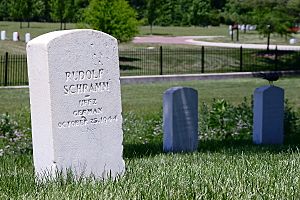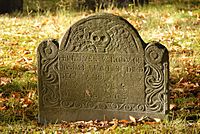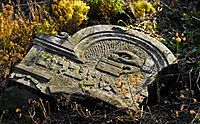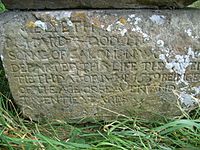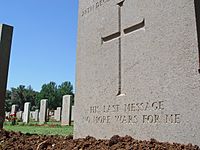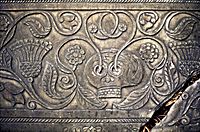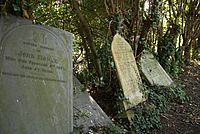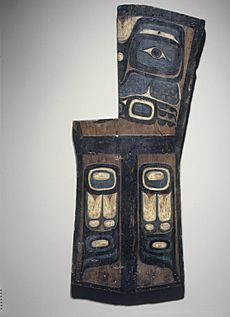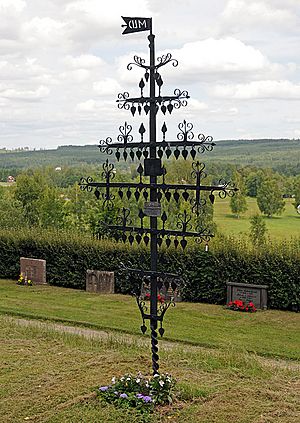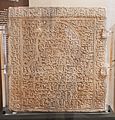Headstone facts for kids
A headstone (also called a gravestone or tombstone) is a special marker, usually made of stone. It helps us know who is buried in a grave below it. These markers can be simple or have beautiful carvings, words (called inscriptions), and pictures.
Contents
What Headstones Are Made Of
Cemeteries often have rules about the size and types of materials allowed for headstones. Some might ask for a more permanent stone marker after a few months if a wooden one was used first. Headstones made of granite, marble, and other stones are usually made and set up by skilled workers called monumental masons.
Cemeteries need to be checked regularly. Stones can shift or even fall, and graves might become overgrown or damaged. Fixing old headstones is a special job for a monumental mason. Even removing plants like ivy needs care so the carvings aren't harmed. Many different materials have been used for grave markers over time.
Different Kinds of Stone
- Fieldstones. The very first grave markers were natural fieldstones. Some were plain, while others had simple carvings like a symbol, the person's name, and age.
- Granite. Granite is a very hard stone. It's tough to carve by hand, but modern tools use computers and sandblasting to create detailed letters and pictures.
- Marble and Limestone. Both limestone and marble are good for carving. Marble is a changed form of limestone. Over time, mild acid in rainwater can slowly wear down marble and limestone, making words hard to read. Marble became popular in the early 1800s, but it cost more.
- Sandstone. Sandstone is strong but also soft enough to carve easily. Some sandstone markers are so well preserved that you can still see the marks from the carving tools! Others have crumbled away. This crumbling happens when water gets between the layers of the stone, freezes, and makes them flake off. In the 1600s, sandstone started to replace fieldstones in Colonial America.
- Slate. Slate can look nice, but it's a bit porous and can also flake apart. It takes lettering well, and the words are often painted white or covered in gold.
-
A headstone in a World War I cemetery in Jerusalem.
Metal, Wood, and Plants

- Iron. Iron grave markers and decorations were popular in the Victorian era in the United Kingdom and other places. They were often made by special factories or local blacksmiths. Cast iron headstones have lasted for many years, but wrought iron often rusts away.
- White Bronze. This material was actually sand-cast zinc, but it was called "white bronze" for marketing. Most zinc grave markers were made by one company in the U.S. between 1874 and 1914. They were sold as being stronger than marble and cheaper.
- Wood. Wood was a popular material during the Georgian and Victorian eras, and likely even before that. Some wooden markers were very fancy, but most don't last more than 50 to 100 years because they break down naturally.
- Planting. Sometimes, trees or shrubs, especially roses, are planted to mark where someone's ashes are buried. A small metal or wooden marker with an inscription might go with the plant.
Images for kids
-
A marble headstone in Singapore with an arched emblem and a statue of Jesus Christ.
-
A gravestone in Canada with an inscription in Canadian Aboriginal Syllabics.
-
Hebrew inscriptions on gravestones in Sobědruhy.
-
A Serbian woman's stone in Gornja Gorevnica, Serbia.
-
An equestrian (horse) design on an 11th-century Swedish gravestone.
-
An Islamic cemetery in Sarajevo, with tall, thin headstones.
-
A typical late-20th-century headstone in Dubuque, Iowa.
-
A headstone for a dog at Tatton Park, Cheshire, England.
-
A late-19th-century headstone with the Masonic square and compass symbol.
-
A personalized gravestone inscription in Berwick, PA.
See also
 In Spanish: Lápida para niños
In Spanish: Lápida para niños


